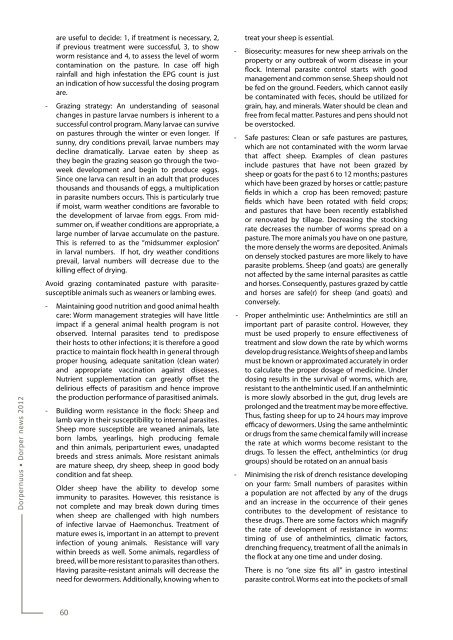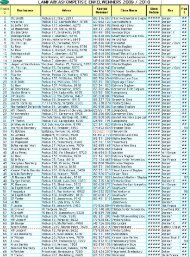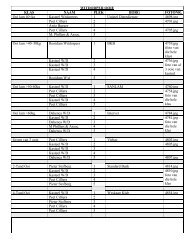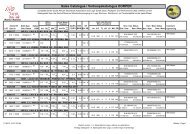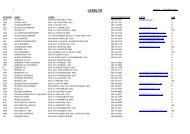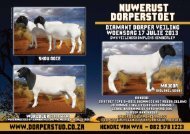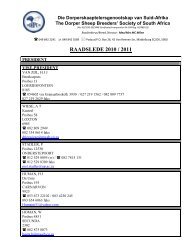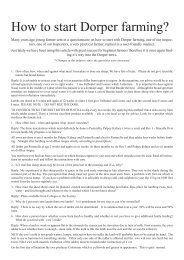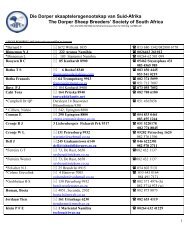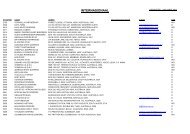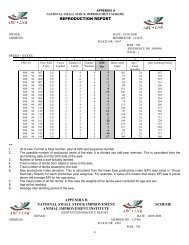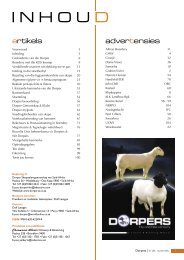D o rp e rn uus • D o rp ernews 2 0 1 2 - Dorper SA
D o rp e rn uus • D o rp ernews 2 0 1 2 - Dorper SA
D o rp e rn uus • D o rp ernews 2 0 1 2 - Dorper SA
You also want an ePaper? Increase the reach of your titles
YUMPU automatically turns print PDFs into web optimized ePapers that Google loves.
Do<strong>rp</strong>e<strong>rn</strong><strong>uus</strong> <strong>•</strong> Do<strong>rp</strong>er news 2012<br />
are useful to decide: 1, if treatment is necessary, 2,<br />
if previous treatment were successful, 3, to show<br />
worm resistance and 4, to assess the level of worm<br />
contamination on the pasture. In case off high<br />
rainfall and high infestation the EPG count is just<br />
an indication of how successful the dosing program<br />
are.<br />
- Grazing strategy: An understanding of seasonal<br />
changes in pasture larvae numbers is inherent to a<br />
successful control program. Many larvae can survive<br />
on pastures through the winter or even longer. If<br />
sunny, dry conditions prevail, larvae numbers may<br />
decline dramatically. Larvae eaten by sheep as<br />
they begin the grazing season go through the twoweek<br />
development and begin to produce eggs.<br />
Since one larva can result in an adult that produces<br />
thousands and thousands of eggs, a multiplication<br />
in parasite numbers occurs. This is particularly true<br />
if moist, warm weather conditions are favorable to<br />
the development of larvae from eggs. From midsummer<br />
on, if weather conditions are appropriate, a<br />
large number of larvae accumulate on the pasture.<br />
This is referred to as the “midsummer explosion”<br />
in larval numbers. If hot, dry weather conditions<br />
prevail, larval numbers will decrease due to the<br />
killing effect of drying.<br />
Avoid grazing contaminated pasture with parasitesusceptible<br />
animals such as weaners or lambing ewes.<br />
- Maintaining good nutrition and good animal health<br />
care: Worm management strategies will have little<br />
impact if a general animal health program is not<br />
observed. Inte<strong>rn</strong>al parasites tend to predispose<br />
their hosts to other infections; it is therefore a good<br />
practice to maintain flock health in general through<br />
proper housing, adequate sanitation (clean water)<br />
and appropriate vaccination against diseases.<br />
Nutrient supplementation can greatly offset the<br />
delirious effects of parasitism and hence improve<br />
the production performance of parasitised animals.<br />
- Building worm resistance in the flock: Sheep and<br />
lamb vary in their susceptibility to inte<strong>rn</strong>al parasites.<br />
Sheep more susceptible are weaned animals, late<br />
bo<strong>rn</strong> lambs, yearlings, high producing female<br />
and thin animals, periparturient ewes, unadapted<br />
breeds and stress animals. More resistant animals<br />
are mature sheep, dry sheep, sheep in good body<br />
condition and fat sheep.<br />
Older sheep have the ability to develop some<br />
immunity to parasites. However, this resistance is<br />
not complete and may break down during times<br />
when sheep are challenged with high numbers<br />
of infective larvae of Haemonchus. Treatment of<br />
mature ewes is, important in an attempt to prevent<br />
infection of young animals. Resistance will vary<br />
within breeds as well. Some animals, regardless of<br />
breed, will be more resistant to parasites than others.<br />
Having parasite-resistant animals will decrease the<br />
need for dewormers. Additionally, knowing when to<br />
60<br />
treat your sheep is essential.<br />
- Biosecurity: measures for new sheep arrivals on the<br />
property or any outbreak of worm disease in your<br />
flock. Inte<strong>rn</strong>al parasite control starts with good<br />
management and common sense. Sheep should not<br />
be fed on the ground. Feeders, which cannot easily<br />
be contaminated with feces, should be utilized for<br />
grain, hay, and minerals. Water should be clean and<br />
free from fecal matter. Pastures and pens should not<br />
be overstocked.<br />
- Safe pastures: Clean or safe pastures are pastures,<br />
which are not contaminated with the worm larvae<br />
that affect sheep. Examples of clean pastures<br />
include pastures that have not been grazed by<br />
sheep or goats for the past 6 to 12 months; pastures<br />
which have been grazed by horses or cattle; pasture<br />
fields in which a crop has been removed; pasture<br />
fields which have been rotated with field crops;<br />
and pastures that have been recently established<br />
or renovated by tillage. Decreasing the stocking<br />
rate decreases the number of worms spread on a<br />
pasture. The more animals you have on one pasture,<br />
the more densely the worms are deposited. Animals<br />
on densely stocked pastures are more likely to have<br />
parasite problems. Sheep (and goats) are generally<br />
not affected by the same inte<strong>rn</strong>al parasites as cattle<br />
and horses. Consequently, pastures grazed by cattle<br />
and horses are safe(r) for sheep (and goats) and<br />
conversely.<br />
- Proper anthelmintic use: Anthelmintics are still an<br />
important part of parasite control. However, they<br />
must be used properly to ensure effectiveness of<br />
treatment and slow down the rate by which worms<br />
develop drug resistance. Weights of sheep and lambs<br />
must be known or approximated accurately in order<br />
to calculate the proper dosage of medicine. Under<br />
dosing results in the survival of worms, which are,<br />
resistant to the anthelmintic used. If an anthelmintic<br />
is more slowly absorbed in the gut, drug levels are<br />
prolonged and the treatment may be more effective.<br />
Thus, fasting sheep for up to 24 hours may improve<br />
efficacy of dewormers. Using the same anthelmintic<br />
or drugs from the same chemical family will increase<br />
the rate at which worms become resistant to the<br />
drugs. To lessen the effect, anthelmintics (or drug<br />
groups) should be rotated on an annual basis<br />
- Minimising the risk of drench resistance developing<br />
on your farm: Small numbers of parasites within<br />
a population are not affected by any of the drugs<br />
and an increase in the occurrence of their genes<br />
contributes to the development of resistance to<br />
these drugs. There are some factors which magnify<br />
the rate of development of resistance in worms:<br />
timing of use of anthelmintics, climatic factors,<br />
drenching frequency, treatment of all the animals in<br />
the flock at any one time and under dosing.<br />
There is no “one size fits all” in gastro intestinal<br />
parasite control. Worms eat into the pockets of small


